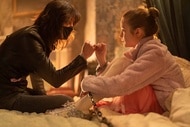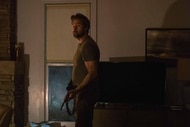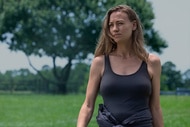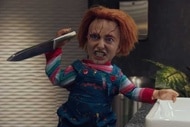Create a free profile to get unlimited access to exclusive videos, sweepstakes, and more!
The makeup in 'Werewolf By Night' makes you scream in color or in black and white
Werewolf By Night's makeup department head reveals how she created those spooky, sometimes unhinged looks, for the spooky MCU feature on Disney+.
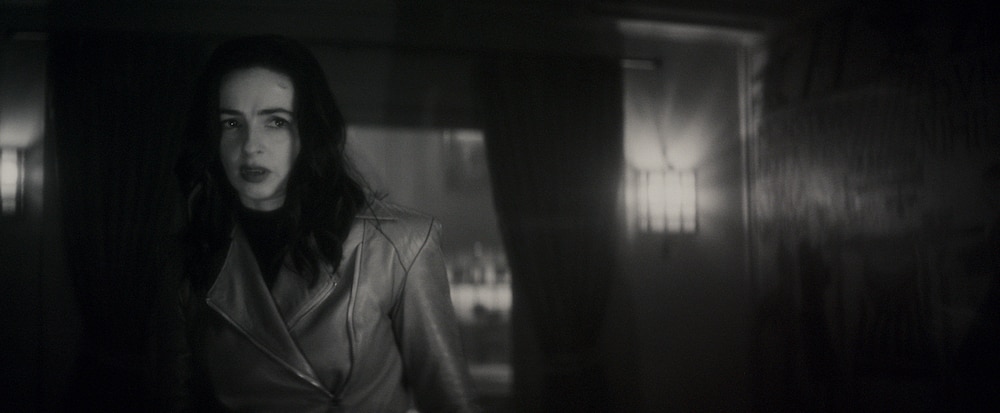
Werewolf by Night is the latest — and spookiest — installment in the Marvel Cinematic Universe. The black-and-white, 53-minute feature, is clearly styled after the Universal Classic Monster movies, and it has brought a new look to the MCU in more ways than one.
SYFY WIRE had the chance to talk with the project’s makeup department head, Ellen Arden, about how she took inspiration from the classic horror films of the ‘30s and ‘40s and also how she made sure that what we saw on screen would look good whether the film was in black and white or color (something that the team wasn’t sure of when they were filming).
Read on for that discussion though be warned: There are mild spoilers about what happens in the MCU’s Werewolf By Night.
Could you talk about how specifically the makeup was informed by the horror movies from the 1930s and 40s?
You can definitely see the influence of 1930s horror films in [Elsa Bloodstone’s (Laura Donnelly)] makeup. We wanted her to be edgy, but not made up. When she comes to the party, you notice right off the bat that she's not like the others — everybody else has ritualistic face paint on. For her, she’s there on business — she’s not there to participate in the hunt quite like they are. And so, when we were thinking about what she was going to look like, because we haven't seen her within the Marvel Cinematic Universe, we wanted her to be really fresh and edgy.
But also we knew that there was a possibility that the film would either be in color or it would be in black and white, so we had to choose things that would be able to translate in both of those mediums. So for her, her skin still had to have that luminosity factor that would work well with adjustments of contrast when the film was actually converted to black and white.
I didn't realize that when you were working on the project you didn't know what the final decision would be on black and white versus color.
We knew that it might end up in black and white but at the same time we knew we had to make it play in both just in case. We had to play it safe and also understand how the colors we were choosing would translate because black and white is so different than color — we had to think in shades and values rather than all these poppy colors.
I thought that Elsa’s stepmom Verussa (Harriet Sansom Harris) had a memorable look when she had that dramatic eye makeup after she takes off her mask. How did you approach creating that look?
With Verussa, you first meet her and she's the widow and she's teary eyed. But, you can clearly deduce that she is also a little delusional, like when she's like talking to her dead husband in the casket.
When we get to the scene where she takes the mask off, we really wanted her to have this huge power moment. She hasn't been part of the hunt until that scene — she was just a bystander but now she's willing to sacrifice her stepdaughter. And so when she takes her mask off, I went to [director Michael Giacchino] and said I had this crazy idea — I would love to have her have this red, just crazy look on her face. She’s grieving, so it's kind of like a watercolor and wet with tears but it’s also really visually striking and unhinged.
That makeup is primary red. And because of that I wanted to make sure that the reds we were using would translate into black and white, because reds and greens are all over the place in black and white. So for her specifically she has this crazy red makeup on, but there's layers built in of these violet tones because it creates texture.
You mentioned earlier that the other hunters had elaborate face paint, including Jack. Can you talk about how you created those looks?
When we had initial conversations about Jack's look, we wanted to pay homage to his ancestors, which he also mentioned in the film, and so Michael wanted to do a Day of the Dead look. We tested a bunch of different looks on people and then we settled on this dialed back, more authentic look that was nothing like the commercialized Day of the Dead makeup that we see regularly. Michael and his producing team contacted an artist — her name is Rosanna Esparza Ahrens — and she created this two-dimensional design.
It was then up to us in the makeup department to translate that into the three-dimensional form we were working in. We created stencils and then we would use an opaque paint that was also diluted down in some areas. Sometimes there was a push and pull with the lighting scenarios, which I felt like really worked well because it's almost like his Day of the Dead makeup was a character in itself. It really organically evolved with him as he was going throughout the story.
So we had that component to him and then he also had a darkened eye socket. We didn't want him to look sinister — we still wanted Jack to be friendly and playful, but also he should fit into this group where all of them have this traditional war paint from wherever they were from. One of our guys was played by Kirk Thatcher — his character is the guy that's a Scottish Nordic type — he's got this inspired color which is like the blue that you would have seen in something like Braveheart, and he's got all of these scars and cuts and abrasions on him all over his hands. We really wanted each of these characters to be individuals, but also to look interesting as a collective.
It’s funny that you said his were blue because obviously I just saw it in black and white. Is Jack's face paint actually white?
Yes, it was white paint, but we had it so it was opaque in areas but then translucent elsewhere. It was difficult. When I was given the design I worried it was going to be a nightmare for continuity since he's moving and running and doing all of this stuff. And also, how is that design going to translate to the werewolf? We had to work with the werewolf team and provide them with what we actually settled on, because we were going to meet Jack far before we met the werewolf while we were shooting. Luckily, it wasn't a nightmare. It was fine. Even when I see it on screen now, I'm just like, “Oh man, we got lucky with him because Gael himself is just so easygoing and easy to work with. He was so great at just sitting for us and making sure that we got to do our part for what we were creating for him.
Werewolf by Night is now streaming on Disney+. This interview has been condensed and lightly edited for clarity.
Looking for more horror action? Check out SYFY's Reginald the Vampire, which airs Wednesday nights on SYFY alongside new episodes of Chucky.







